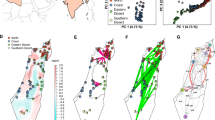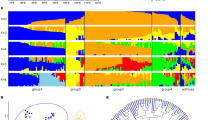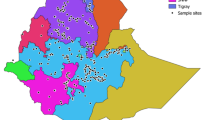Abstract
Long primer PCR (LP-PCR) markers specifically targeted to sequences involved in the response to abiotic stress were utilised to analyse genetic variation within and among wild barley populations from Israel.Populations were sampled in locations reflecting a wide range of habitats and the potential correlation between genetic variation and ecogeographic parameters was examined. A high level of polymorphism was observed. Most of the variability was due to differences within populations, however a substantial portion of genetic variation (36%) could be attributed to differences among populations, indicating local adaptation of genotypes to microclimatic conditions. Moreover, clustering and ordination techniques showed that genotypes grouped together according to their area of origin and were separated on thebasis of ecogeography, chiefly by a combination of temperature, altitude and rainfall variables. Finally, 28% of the polymorphic PCR fragments were significantly correlated with ecogeographic parameters. Our results demonstrate the effectiveness of PCR-based molecular markers targeted to environmentally regulated genes in detecting ‘useful’ variation andthus in monitoring the impact exerted by adaptation to the environment ongenetic differentiation.
Similar content being viewed by others
References
Birkenmeier E.H., Schneider U. and Thurston S.J. 1992. Finger-printing genomes by use of PCR with primers that encode protein motifs or contain sequences that regulate gene expression. Mammal. Genome 3: 537–545.
Caetano-Anollés G. 1993. Amplifying DNA with arbitrary oligonucleotide primers. PCR Methods Applic. 3: 85–94.
Caetano-Anollés G. 1996. Scanning of nucleic acids by in vitro amplification: new developments and applications. Nature Biotechnol. 14: 1668–1674.
Campbell S.A. and Close T.J. 1997. Dehydrins: genes, proteins and associations with phenotypic traits. New Phytol. 137: 61–74.
Close T.J. and Chandler P.M. 1990. Cereal dehydrins: serology, gene mapping and potential functional roles. Austr. J. Plant Physiol. 17: 333–334.
Dawson I.K., Chalmers K.J., Waugh R. and Powell W. 1993. Detection and analysis of genetic variation in Hordeum spontaneum populations from Israel using RAPD markers. Mol. Ecol. 2: 151–159.
Dubcovsky J., Luo M.C. and Mdvorak J. 1995. Linkage relationships among stress induced genes in wheat. Theor. Appl. Genet. 91: 795–801.
Excoffier L., Smouse P. and Quattro J. 1992. Analysis of molecular variance inferred from metric distances among DNA haplotypes: application to human mitochondrial DNA restriction data. Genetics 131: 479–491.
Ezer A.D., Williams R.W. and Goldowitz D. 1996. Arbitrary Primer PCR of dog DNA with estimates of average heterozygosity. J. Hered. 87: 450–455.
Favatier F., Bornman L., Hightower L.E., Gunther E. and Polla B.S. 1997.Variation in hsp gene expression and Hsp polymorphism: do they contribute to differential disease susceptibility and stress tolerance? Cell Stress Chap. 2: 141–155.
Forster B.P., Russell J.R., Ellis R.P., Handley L.L., Robinson D., Hackett C.A. et al. 1997. Locating genotypes and genes for abiotic stress tolerance in barley: a strategy using maps, markers and the wild species. New Phytol. 137: 141–147.
Gillings M. and Holley M. 1997. Amplification of anonymous DNA fragments using pairs of long primers generates reproduceible DNA fingerprints that are sensitive to genetic variation. Electrophoresis 18: 1512–1518.
Gulli M., Maestri E., Hartings H., Raho G., Perrotta C., Devos K.M. et al. 1995. Isolation and characterization of abscisic acid inducible genes in barley seedlings and their responsiveness to environmental stress. Plant Physiol. (Life Sci. Adv.) 14: 89–96.
Hayes P.M., Blake T., Chen T.H.H., Tragoonrung S., Chen F., Pan A. et al. 1993. Quantitative trait loci on barley (Hordeum vulgare L.) chromosome 7 associated with components of winterhardiness. Genome 36: 66–71.
Hoffman A.A. and Parsons P.A. 1991. Evolutionary genetics and environmental stress. Oxford University Press, Oxford.
Laurie D.A., Pratchnett N., Bezant J.H. and Snape J.W. 1995. RFLP mapping of five major genes and eight quantitative loci controlling flowering time in a winter x spring barley (Hordeum vulgare L.) cross. Genome 38: 575–585.
Leonards-Shippers C., Gieffers W., Schäfer-Pregl R., Ritter E., Knapp S.J., Salamini F. et al. 1994. Quantitative resistance to Phytophthora infestans in potato: a case study for QTL mapping in allogamous plant species. Genetics 137: 67–77.
Marmiroli N., Pavesi A., Di Cola G., Hartings H., Raho G., Conte M.R. et al. 1993. Identification, characterization, and analysis of cDNA and genomic sequences encoding two different small heat shock proteins in Hordeum vulgare L. Genome 36: 1111–1118.
Marmiroli N., Malcevschi A. and Maestri E. 1998. Application of stress responsive genes RFLP analysis to the evaluation of genetic diversity in plants. In: Karp A., Isaac P.G. and Ingram D.S. (eds), Molecular Tools for Screening Biodiversity. Chapman & Hall, London, pp. 464–470.
Nei M. 1973. Analysis of gene diversity in subdivided populations. Proc. Natl. Acad. Sci. USA 70: 3321–3323.
Nei M. 1978. Estimation of average heterozygosity and genetic distance from a small number of individuals. Genetics 89: 583–590.
Nevo E. 1992. Origin, evolution, population genetics and resources for breeding of wild barley, Hordeum spontaneum, in the Fertile Crescent. In: Peter R. (ed.), Barley: Genetics, Biochemistry, Molecular Biology and Biotechnology. C. A. B. International, Shewry, pp. 19–43.
Nevo E., Zohary D., Brown A.H.D. and Haber M. 1979. Genetic diversity and environmental associations of wild barley, Hordeum spontaneum, in Israel. Evolution 33: 737–756.
Nevo E., Beiles A. and Zohary D. 1986. Genetic resources of wild barley in the Near East: structure, evolution and application in breeding. Biol. J. Linn. Soc. 27: 355–380.
Nevo E., Baum B., Beiles A. and Johnson D.A. 1998. Ecological correlates of RAPD DNA diversity of wild barley, Hordeum spontaneum in the Fertile Crescent. Genet. Resour. Crop Evol. 45: 151–159.
Pakniyat H., Powell W., Baird E., Handley L.L., Robinson D., Scrimgeour C.M. et al. 1997. AFLP variation in wild barley (Hordeum spontaneum C. Koch) with reference to salt tolerance and associated ecogeography. Genome 40: 332–341.
Pan A., Hayes P.M., Chen F., Chen T.H.H., Blake T., Wright S. et al. 1994. Genetic analysis of the components of winter hardiness in barley (Hordeum vulgare L.). Theor. Appl. Genet. 89: 900–910.
Parsons P.A. 1996. Conservation strategies: adaptation to stress and the preservation of genetic diversity. Biol. J. Linn. Soc. 58: 471–482.
Pérez de la Vega M. 1996. Plant genetic adaptedness to climatic and edaphic environment. Euphytica 92: 27–38.
Plucknett D.L., Smith N.J.H., Williams J.T. and Anishetty N.M. 1983. Crop germplasm conservation and developing countries. Science 220: 163–169.
Quarrie S.A., Gulli M., Calestani C., Steed A. and Marmiroli N. 1994. Location of a gene regulating drought-induced abscisic acid production on the long arm of chromosome 5A of wheat. Theor. Appl. Genet. 89: 794–800.
Reynolds J., Weir B.S. and Cockerham C.C. 1983. Estimation for the coancestry coefficient: basis for a short-term genetic distance. Genetics 105: 767–779.
Rohlf F.J. 1993. NTSYS: Numerical Taxonomy and Multivariate Analysis System, version 1.8. Exeter Software, Setauket, NY.
Russell J.R., Fuller J.D., Macaulay M., Hatz B.G., Jahoor A., Powell W. et al. 1997. Direct comparison of levels of genetic variation among barley accessions detected by RFLPs, AFLPs, SSRs and RAPDs. Theor. Appl. Genet. 95: 714–722.
Sambrook J., Fritsch E.F. and Maniatis T. 1989. Molecular cloning: a laboratory manual. Cold Spring Harbor Laboratory Press, Cold Spring Harbor, NY.
Schierwater B. 1995. Arbitrarily amplified DNA in systematics and phylogenetics. Electrophoresis 16: 1643–1647.
Schneider U., Kueffer J.M., Roessli D. and Excoffier L. 1997. Arlequin Version 1.1: A Software for Population Genetic Data Analysis. Genetics and Biometry Laboratory, University of Geneva, Switzerland.
Slatkin M. 1995. A measure of population subdivision based on microsatellite allele frequencies. Genetics 139: 457–462.
Virk P.S., Ford-Lloyd B.V., Jackson M.T. and Newbury H.J. 1995. Use of RAPD for the study of diversity within plant germplasm collections. Heredity 74: 170–179.
Author information
Authors and Affiliations
Corresponding author
Rights and permissions
About this article
Cite this article
Liviero, L., Maestri, E., Gulli, M. et al. Ecogeographic adaptation and genetic variation in wild barley, Application of molecular markers targeted to environmentally regulated genes. Genetic Resources and Crop Evolution 49, 133–144 (2002). https://doi.org/10.1023/A:1014792509087
Issue Date:
DOI: https://doi.org/10.1023/A:1014792509087




